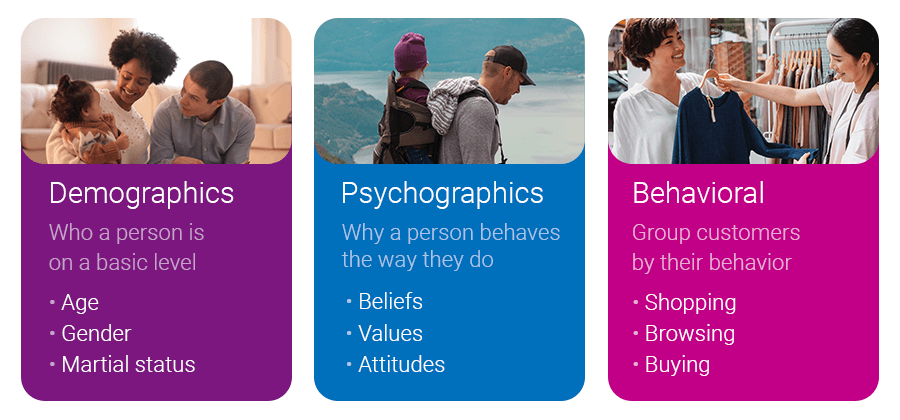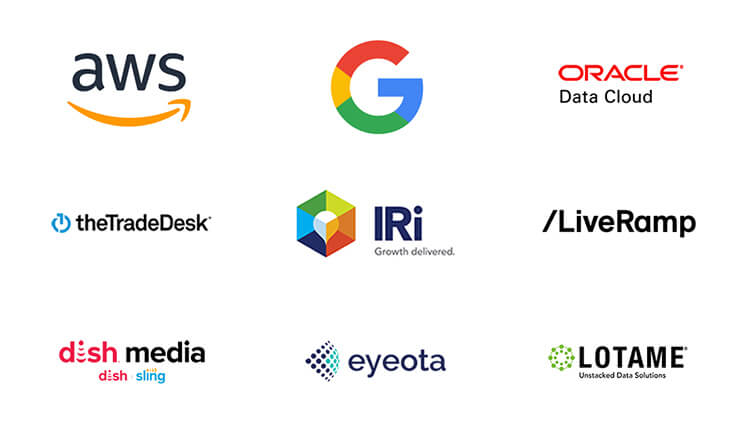Psychographic segmentation
Why psychographic segmentation is essential to your marketing strategy
Using psychographic segmentation, you can group your customers by various psychological factors. This approach is helpful because it allows you to make sense of what motivates the various groupings of your audience and how you can change your products and messaging to engage those groups of the audience more effectively. We’re here to guide you through the complexities of psychographic segmentation so you can connect with your audiences in genuine ways.
Psychographic definition: The science of grouping your audience into different segments based on psychological factors and personality traits.
Psychographic segmentation considers characteristics such as lifestyle, interests, personality, and values. Let's look at how each can affect your marketing campaigns.

What day-to-day activities does a given person take part in? What personal associations or attachments would they have? How does their living situation influence the things they care about?
For instance, if they are a parent, they probably have different daily activities and concerns than the average single college student, and both would have a completely different lifestyle to a retired empty-nester.
It's something we learn in grade school, but it bears repeating: each person has different likes and dislikes from their neighbor — and that's okay.
A person's interests are different from their lifestyle. While a lifestyle involves the concerns and obligations that come with a person's role in life, interests are the extracurriculars. What hobbies does a person spend their time on? What kind of media do they consume?
If you find that your target audience has considerable overlap with a particular hobby, sport, pastime, or fandom, reference it in your messaging. You might even buy ad space in channels that your target audience engages with.
What traits and tendencies does a person consistently show throughout life? Are they more practical or creative? Calm or anxious? Extraverted or introverted?
When you understand which personalities are attracted to your products and services, you can cater your messaging toward them in a way that drives positive engagement. When people feel like you recognize and speak to their unique style of being human, they usually respond well to it.
Where does a person fall on the political spectrum? What moral, religious, or ideological beliefs do they hold? Additionally, which things does a person view as “right” or “wrong,” and what principles do they view as inherently important?
While it’s not out of the ordinary for target audiences to be diverse in this sense, others will attract audiences that line up along particular belief systems. Be aware of your own audience and what beliefs they tend to hold. This can guide the tone of your messaging and inform the type of products and services you offer or emphasize in marketing.
Demographics focus on physical or statistical characteristics — like age, gender, marital status, and more. Psychographics refers to more subjective psychological factors like beliefs, values, and attitudes.
Demographics tell you who a person is on a basic level. Psychographics, however, tell you why that person behaves the way they do.
In marketing, it's crucial to segment your customers using both psychographic and demographic segmentations because both methods, when used together, give you a more accurate idea of what to expect from your audience.
It’s tempting to look at psychographics and behavioral segmentation and conclude that they are different words for the same thing. However, there’s a small but important difference.
Behavioral segmentation focuses on grouping your customers by their behavior. Specifically, we’re talking about the customer’s browsing, shopping, and buying behavior. How do they interact with products and sellers before, during, and after the sale?
As stated earlier, psychographics concerns the “why” of a customer’s behavior. What are their feelings, thoughts, and opinions that lead them to act the way they do?
If psychographic data is the cause (the underlying personality and psychology), then the behavior is the effect (the outward expression of that personality).
Both psychographic segmentation and behavioral segmentation can be used to focus on particular groups of people within your customer base, either individually or together. Whether you use one or both methods will depend on whether it’s most relevant to pay closer attention to the psychographic profile of customers or their buying behavior. This consideration can change from campaign to campaign.

Without the right data, many companies take a shot in the dark, making assumptions about their customers, and producing one-size-fits-all products, services, messaging, and marketing. This approach won’t deliver what your customers are truly asking for, meaning they aren’t getting what they need from the product. You’ll only be able to fully deliver on a promise when you know what you’re promising, so it’s essential to figure out what people want and what you can reasonably provide.
Take a step back from marketing for a moment and think about your personal relationships. The people you know the most about are likely the ones you are closest with. Because you care about those people, you’ve learned their likes, dislikes, interests, and personality quirks. Having better knowledge of what makes your friends and loved ones tick gives you a better ability to be a good friend to them.
Similarly, if you want more positive engagement with your customer base, it makes sense to get to know, collectively, who they are, what they need, and what they want.
When you first create your product, you probably have your own idea of how the product will be used. You saw a need and made a product to fill it.
However, customers can be crafty. They will often find creative applications of your product that you might not have thought of, and those new uses of your product might even become more popular than what you originally intended.
When you gather psychographic data and survey your customer base, you can understand how your customer base’s different segments interact with your products. You might even find that different segments of your customer base have different needs and wants for your product. With all this data gathered, you can alter your products or messaging to fit those needs.
A buyer persona is the hypothetical ideal customer you’ll be targeting. If you considered your average customer as one theoretical person, what traits does that person have, what are their views on the world, and what do they value? Understanding who this persona is, allows you to tailor your messaging, branding, and products to appeal to that specific person.
While this is not an exhaustive list, here are a few of the most common ways that you can gather psychographic data to build an accurate buyer persona of your customer base.
By sending carefully crafted surveys to your customers, you can hear directly from your target audience to learn more about them. With a broad enough sample size and the right questions, a small cross-section of your audience can tell you most of what you need to know to engage with the various segments drawn to your products.
In online reviews, customers tend to share exactly what they liked and disliked about a product, and in doing so, they often portray certain things about their personality, likes, and dislikes. By taking a close look at the reviews of your products, wherever they might be posted, you can gain a pretty good idea of what you’re doing right, what you need to improve, and which segments of your market are calling for change.
By bringing together a diverse group of people and carefully noting their responses to your products and messaging, you can efficiently find out what your customer base really thinks. Additionally, the setup of a focus group allows you to pinpoint where each market segment disagrees and why.
The social media likes, shares, retweets, and other interactions that a person makes online say a lot about personality and online behavior. Through social media listening and analytics software, you take an in-depth look at how your audience interacts with your brand. You can even isolate which segments engage in specific ways and determine what factors influenced it.
We can help you create marketing strategies catered to the specific preferences and behaviors of your current and prospective customers. We specialize in helping brands discover data-driven insights to make an everlasting impact on consumers.
Our data and identity products and services can help you learn more about customers and target audiences, leverage data resources, improve targeted marketing, create personalized campaigns, and optimize marketing strategies.
With us, you’ll understand your consumers better, make more effective data-informed decisions, and increase your customer base for bigger revenue.

This site is protected by reCAPTCHA and the Google Privacy Policy and Terms of Service apply.